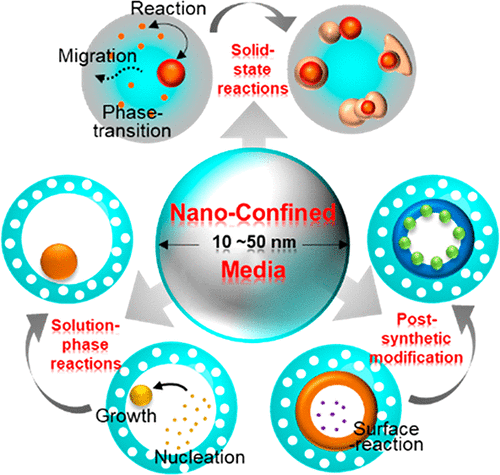当前位置:
X-MOL 学术
›
Acc. Chem. Res.
›
论文详情
Our official English website, www.x-mol.net, welcomes your
feedback! (Note: you will need to create a separate account there.)
Spatially Confined Formation and Transformation of Nanocrystals within Nanometer-Sized Reaction Media
Accounts of Chemical Research ( IF 16.4 ) Pub Date : 2018-10-16 00:00:00 , DOI: 10.1021/acs.accounts.8b00338 Amit Kumar 1 , Ki-Wan Jeon 1 , Nitee Kumari 1 , In Su Lee 1
Accounts of Chemical Research ( IF 16.4 ) Pub Date : 2018-10-16 00:00:00 , DOI: 10.1021/acs.accounts.8b00338 Amit Kumar 1 , Ki-Wan Jeon 1 , Nitee Kumari 1 , In Su Lee 1
Affiliation

|
The extensive research performed in the past two decades has enabled the production of a range of colloidal nanocrystals, mostly through solution-based procedures that generate and transform nanostructures in bulk-phase solutions containing precursors and surfactants. However, the understanding and control of each nanocrystal (trans)formation step during the synthesis are still complicated because of the high complexity of this process, in which multiple diverse events such as nucleation, subsequent growth, attachment, and ripening occur simultaneously in bulk suspensions. Unlike well-established solution-based methods, solid-state reactions, which had been at the forefront of traditional inorganic materials chemistry, are quite rarely utilized in the realm of nanomaterials because of the high temperatures required for most solid-state reactions, as a result of which the clusters and NCs are prone to migrate through the bulk reaction medium and sinter together uncontrollably into large particles. We have been pursuing the “nanospace-confined approach” to explore the use of a variety of solid and hollow silica nanoparticles as either solid-state or solution-phase reaction media to carry out the syntheses and transformations of nanocrystals in a unique microenvironment, partitioning the reactants, intermediates, and transition states from the rest of the bulk reaction medium. Such nanoconfined systems have the potential not only to enable efficient and selective nanocrystal conversion chemistries but also to provide fundamental understanding pertaining to the synthetic evolution of nanostructures and transient mechanistic steps. The unique spaces with sizes of a few tens of nanometers inside nanoconfined systems offer the opportunity to observe and elucidate novel deconvoluted chemical phenomena that are impossible to investigate in bulk systems, and comprehensive understanding of nanoconfined chemistry can be implicated in explaining and controlling the macroscopic chemical behaviors. This Account describes our focused research on developing spatially confined platforms for nanocrystal syntheses and transformations, highlighting our diversity-oriented strategy, namely, the “postdecoration approach”, which results in the evolution of new nanocatalytic sites in a preformed cavity for diversifying and controlling their morphologies, number, density and combinations. We discuss key examples of the “nanoconfined solid-state conversion approach” that involve novel reactions of nanocrystals within thermally stable solid silica nanospheres to synthesize and transform complex hybrid nanocrystals with increased complexity and functionality. In addition, an enlightening discussion of the examples of nanocrystal syntheses and conversions in nanoconfined solutions inside enclosed and exposed cavities of silica nanospheres is included. Finally, the important applications of nanospace-confined systems in various fields are also briefly discussed.
中文翻译:

纳米尺寸反应介质中纳米晶体的空间受限形成和转变
在过去的二十年中进行的广泛研究已使多种胶体纳米晶体的生产成为可能,主要是通过基于溶液的程序在含有前体和表面活性剂的本体相溶液中生成和转化纳米结构。然而,由于该过程的高度复杂性,在合成过程中对每个纳米晶体(转化)步骤的理解和控制仍然很复杂,在该过程中,大量悬浮液同时发生了成核,随后的生长,附着和成熟等多种多样的事件。与完善的基于溶液的方法不同,固态反应本来是传统无机材料化学领域的最前沿,但由于大多数固态反应都需要高温,因此很少用于纳米材料领域。结果,团簇和NC易于通过本体反应介质迁移,并不受控制地烧结成大颗粒。我们一直在追求“纳米空间限制方法”,以探索使用各种固态和中空二氧化硅纳米颗粒作为固态或溶液相反应介质,以在独特的微环境中进行纳米晶体的合成和转化,分配其余本体反应介质中的反应物,中间体和过渡态。这样的纳米受限系统不仅具有实现高效和选择性的纳米晶体转化化学的潜力,而且还提供与纳米结构的合成演化和瞬态机理步骤有关的基本理解。纳米密闭系统内部只有几十纳米大小的独特空间,为观察和阐明在本体系统中无法研究的新的去卷积化学现象提供了机会,并且对纳米密闭化学的全面理解可能有助于解释和控制宏观化学行为。该报告描述了我们对开发用于纳米晶体合成和转化的空间受限平台的重点研究,重点介绍了我们面向多样性的策略,即“后装饰方法”,该策略导致了预先形成的空腔中新的纳米催化位点的演化,从而实现了对其的多样化和控制。形态,数量,密度及其组合。我们讨论了“纳米约束固态转换方法”的关键示例,该方法涉及在热稳定的固态二氧化硅纳米球中纳米晶体的新颖反应,以合成和转化复杂的杂化纳米晶体,并增加了复杂性和功能性。另外,还包括对二氧化硅纳米球的封闭腔和暴露腔内的纳米受限溶液中纳米晶体合成和转化的示例的启发性讨论。最后,还简要讨论了纳米空间受限系统在各个领域的重要应用。包括对二氧化硅纳米球封闭和暴露腔内纳米受限溶液中纳米晶体合成和转化的实例的启发性讨论。最后,还简要讨论了纳米空间受限系统在各个领域的重要应用。包括对二氧化硅纳米球封闭和暴露腔内纳米受限溶液中纳米晶体合成和转化的实例的启发性讨论。最后,还简要讨论了纳米空间受限系统在各个领域的重要应用。
更新日期:2018-10-16
中文翻译:

纳米尺寸反应介质中纳米晶体的空间受限形成和转变
在过去的二十年中进行的广泛研究已使多种胶体纳米晶体的生产成为可能,主要是通过基于溶液的程序在含有前体和表面活性剂的本体相溶液中生成和转化纳米结构。然而,由于该过程的高度复杂性,在合成过程中对每个纳米晶体(转化)步骤的理解和控制仍然很复杂,在该过程中,大量悬浮液同时发生了成核,随后的生长,附着和成熟等多种多样的事件。与完善的基于溶液的方法不同,固态反应本来是传统无机材料化学领域的最前沿,但由于大多数固态反应都需要高温,因此很少用于纳米材料领域。结果,团簇和NC易于通过本体反应介质迁移,并不受控制地烧结成大颗粒。我们一直在追求“纳米空间限制方法”,以探索使用各种固态和中空二氧化硅纳米颗粒作为固态或溶液相反应介质,以在独特的微环境中进行纳米晶体的合成和转化,分配其余本体反应介质中的反应物,中间体和过渡态。这样的纳米受限系统不仅具有实现高效和选择性的纳米晶体转化化学的潜力,而且还提供与纳米结构的合成演化和瞬态机理步骤有关的基本理解。纳米密闭系统内部只有几十纳米大小的独特空间,为观察和阐明在本体系统中无法研究的新的去卷积化学现象提供了机会,并且对纳米密闭化学的全面理解可能有助于解释和控制宏观化学行为。该报告描述了我们对开发用于纳米晶体合成和转化的空间受限平台的重点研究,重点介绍了我们面向多样性的策略,即“后装饰方法”,该策略导致了预先形成的空腔中新的纳米催化位点的演化,从而实现了对其的多样化和控制。形态,数量,密度及其组合。我们讨论了“纳米约束固态转换方法”的关键示例,该方法涉及在热稳定的固态二氧化硅纳米球中纳米晶体的新颖反应,以合成和转化复杂的杂化纳米晶体,并增加了复杂性和功能性。另外,还包括对二氧化硅纳米球的封闭腔和暴露腔内的纳米受限溶液中纳米晶体合成和转化的示例的启发性讨论。最后,还简要讨论了纳米空间受限系统在各个领域的重要应用。包括对二氧化硅纳米球封闭和暴露腔内纳米受限溶液中纳米晶体合成和转化的实例的启发性讨论。最后,还简要讨论了纳米空间受限系统在各个领域的重要应用。包括对二氧化硅纳米球封闭和暴露腔内纳米受限溶液中纳米晶体合成和转化的实例的启发性讨论。最后,还简要讨论了纳米空间受限系统在各个领域的重要应用。











































 京公网安备 11010802027423号
京公网安备 11010802027423号